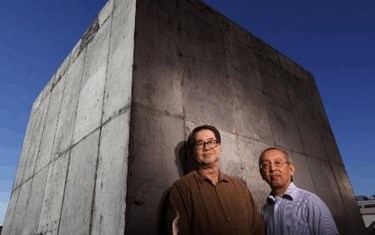Spray-On Conductive Concrete Shield Electronics From EMP Attacks
By Jof Enriquez,
Follow me on Twitter @jofenriq

Scientists from the University of Nebraska-Lincoln (UNL) have invented a type of concrete mixture that can shield electronic systems from electromagnetic pulse (EMP) attacks and coronal mass ejections (CMEs). It's a cost-effective alternative to current EMP shielding solutions like metal enclosures.
Christopher Tuan and Lim Nguyen were originally developing a conductive concrete formulation for de-icing and surface heating road surfaces, when they made a serendipitous discovery that the mixture has the ability to block electromagnetic energy. A key material in the mixture called magnetite, which can readily absorb microwaves, was added with carbon and metal components for better absorption, as well as reflection of electromagnetic waves that can stall or fry electronics.
"EMP is very lethal to electronic equipment,” said Tuan, professor of civil engineering at UNL, in a news release. “We found a key ingredient that dissipates wave energy. This technology offers a lot of advantages so the construction industry is very interested.”
The engineers partnered with Florida-based American Business Continuity Group (ABC), a builder of specialized, hardened structures, for the EMP-proof concrete mixture to be applied with the company's “shotcrete” spray-on construction method.
Shotcrete presents a cost-effective solution through retrofitting existing infrastructure, as it only needs to be sprayed on the outside of the building, or inside the building's walls, as compared to tearing down entire walls and replacing them with new ones, or installing metal enclosures like a Faraday cage to protect sensitive electronic equipment.
“The concrete can provide what we call a multi-threat structure," said Nguyen, professor of electrical and computer engineering at UNL, who evaluated the prototype building at Lakeland, Florida. "The structure has to be able to withstand an attack either by an explosive or an electromagnetic attack or other scheme," even exceeding military shielding requirements.
The patent-protected EMSS-Electromagnetic Shielding Shotcrete enables "high strength, rigorously tested structures that exceed the electromagnetic shielding requirements of Mil Std 188-125 as well as the higher frequencies of IEMI (Intentional Electromagnetic Interference) weapons and Tempest," according to a news release.
ABC claims that the conductive concrete mix has the ability to shield facilities from High Altitude Electromagnetic Pulse (HEMP), Intentional Electromagnetic Interference (IEMI), Emanations Eavesdropping (TEMPEST), terrorist ballistic/blast attacks and natural disasters.
The conductive concrete may also be used to protect static-sensitive devices as it can be used to provide grounding and thus removal of static buildup. This would benefit semiconductor producers, research laboratories, R&D departments, factories, and even hobby workshop flooring, according to All About Circuits.
Someday, it can also find application in residential and commercial buildings, where we now find a gamut of devices and appliances increasingly connected to the vulnerable Internet of Things ecosystem.
